 |
|
Highlights
from Wednesday, 22 November:
 Delegates convened in Plenary to hear statements
from 34 Parties, thus completing the high-level segment that began
on Tuesday. Senior government representatives also met in informal
high-level Plenary sessions and closed informal consultations to
advance negotiations on key outstanding issues. These negotiations
focused on the following four "clusters" or "boxes" of key
issues identified by COP-6 President Pronk: (a) capacity building,
technology transfer, adverse effects and guidance to the GEF; (b)
the mechanisms; (c) land use, land-use change and forestry (LULUCF);
and (d) policies and measures (P&Ms), compliance, and
accounting, reporting and review under Protocol Articles 5, 7 and 8. Delegates convened in Plenary to hear statements
from 34 Parties, thus completing the high-level segment that began
on Tuesday. Senior government representatives also met in informal
high-level Plenary sessions and closed informal consultations to
advance negotiations on key outstanding issues. These negotiations
focused on the following four "clusters" or "boxes" of key
issues identified by COP-6 President Pronk: (a) capacity building,
technology transfer, adverse effects and guidance to the GEF; (b)
the mechanisms; (c) land use, land-use change and forestry (LULUCF);
and (d) policies and measures (P&Ms), compliance, and
accounting, reporting and review under Protocol Articles 5, 7 and 8.
>>
Continued on Today's Negotiation page>>
Above photo (L-R): Angry protesters that disrupted the
Informal Consultations on Compliance met with UNFCCC Executive
Secretary Michael Zammit Cutajar and COP-6 President Jan
Pronk who invited them to join the fora for discussions. The
protesters however declined the invitation and walked out the of the
session after giving a brief statement.
|
Informal High Level Plenary and Consultations:
Box A
CAPACITY
BUILDING, TECHNOLOGY TRANSFER, ADVERSE EFFECTS AND GUIDANCE
to the GEF
|
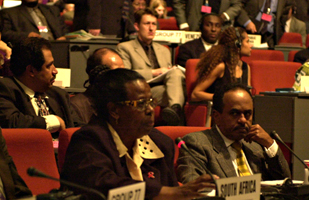 The
informal high-level Plenary held in the morning began with a report
by co-facilitator Minister Mabudhafasi (South Africa) on progress
made Tuesday on "Box A" issues. She reported that participants
had recognized the need to move toward concrete action, and
highlighted the value of the presence of ministers to find agreement
on key political issues. The
informal high-level Plenary held in the morning began with a report
by co-facilitator Minister Mabudhafasi (South Africa) on progress
made Tuesday on "Box A" issues. She reported that participants
had recognized the need to move toward concrete action, and
highlighted the value of the presence of ministers to find agreement
on key political issues.
Left photo: H.E. Minister Rejoice Mabudafhasi (South
Africa) making an intervention during the informal high-level
plenary
|
|
MECHANISMS
|
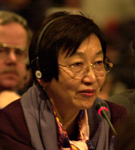 During
the morning informal high-level Plenary, co-facilitator Minister
Kawaguchi (Japan) reported on progress made in the "Box B"
group. She highlighted the remaining divergent positions on the
issues of supplementarity, and said the EU had expressed interest in
a possible qualitative ceiling. On fungibility and assigned amounts,
she reported that India and the US were conducting consultations. On
CDM, she said the majority opposed an indicative list of projects.
She added that France, Korea, Brazil and Norway were working on the
issue of a prompt start and that divergence remained on a possible
unilateral CDM. During
the morning informal high-level Plenary, co-facilitator Minister
Kawaguchi (Japan) reported on progress made in the "Box B"
group. She highlighted the remaining divergent positions on the
issues of supplementarity, and said the EU had expressed interest in
a possible qualitative ceiling. On fungibility and assigned amounts,
she reported that India and the US were conducting consultations. On
CDM, she said the majority opposed an indicative list of projects.
She added that France, Korea, Brazil and Norway were working on the
issue of a prompt start and that divergence remained on a possible
unilateral CDM.
Left photo: H.E. Minister Kawaguchi (Japan) presenting
her report to informal high-level plenary on progress made in the
"Box B" group
|
| LULUCF
|
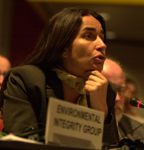 Minister Carabias Lillo of Mexico (left) said the group in
the afternoon had explored different conditions for including
Article 3.4 activities, possibly even in the first commitment
period, under controlled conditions. She explained that bilateral
meetings had been held with the aim of exploring an approach to
this, but the issue had not yet been resolved. She said the second
meeting in the evening had focused on the inclusion of LULUCF
activities under the CDM, and some agreement as well as concerns
had emerged. She noted that the group would be able to bring
forward proposals on the issues, but more time was needed. Minister Carabias Lillo of Mexico (left) said the group in
the afternoon had explored different conditions for including
Article 3.4 activities, possibly even in the first commitment
period, under controlled conditions. She explained that bilateral
meetings had been held with the aim of exploring an approach to
this, but the issue had not yet been resolved. She said the second
meeting in the evening had focused on the inclusion of LULUCF
activities under the CDM, and some agreement as well as concerns
had emerged. She noted that the group would be able to bring
forward proposals on the issues, but more time was needed.
|
| COMPLIANCE,
POLICIES AND MEASURES, AND ACCOUNTING, REPORTING AND REVIEW
UNDER PROTOCOL ARTICLES 5, 7 AND 8 |

SWITZERLAND said the integrity
of the review process requires that the competence of reviewers
be a priority, and suggested training as a way to reach both
this objective and ensure equitable geographical representation. Following a question by President Pronk, he said it was
reasonable to have full representation in only one of the two
branches of the compliance committee.
Left
photo: (L-R) Beat Nobs and Philippe Roch in a
light discussion during the informal high-level plenary
|
|

ARGENTINA
expressed concern over the adoption of a compliance
regime and a possible amendment of the Protocol before
its entry into force. Opposed by BRAZIL, he called on
Parties not to push for the most comprehensive and
complex regime, but one that will be "viable."
Right photo: Raul Estrada (Argentina) making
a passionate intervention during the informal high-level
plenary.
|
|
|
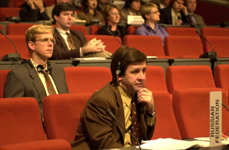
AUSTRALIA
and the RUSSIAN FEDERATION argued for a non-binding regime
and said their countries were more concerned about their own
compliance than that of others.
Right
photo: Member of the Russian delegation giving an intervention during the
informal high-level segment
|
|
Policies and Measures
|
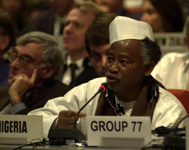
Nigeria
speaking on behalf of the G-77/CHINA said the whole of Protocol
Article 2 - including provision for minimizing adverse effects -
should be referred to in the decision. He suggested keeping the
reference to "Annex I Parties," as non-Annex I Parties would
otherwise be required to implement these obligations.
Right photo: H.E. Alhaji Sani Zangon Daura making an intervention
during the informal high-level plenary.
|
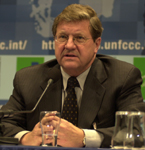 CANADA
supported the voluntary payments to a compliance fund to deal with
mitigation projects. IRAN said such a fund should also
minimize the adverse impact of response measures. AOSIS said payment
in a voluntary fund would actually provide Parties with an
additional flexible mechanism CANADA
supported the voluntary payments to a compliance fund to deal with
mitigation projects. IRAN said such a fund should also
minimize the adverse impact of response measures. AOSIS said payment
in a voluntary fund would actually provide Parties with an
additional flexible mechanism
Right photo: Lloyd Axworthy (Canada) making a statment during
a Canadian press conference
|
| PROTESTERS:
|
|

|
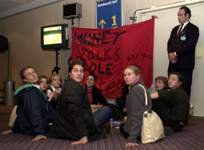
|

|
|
Above: Photos of
various protesters from left-right: sink stoppers stand in, sit ins
outside the contact group and the beam climbers.
|
|













